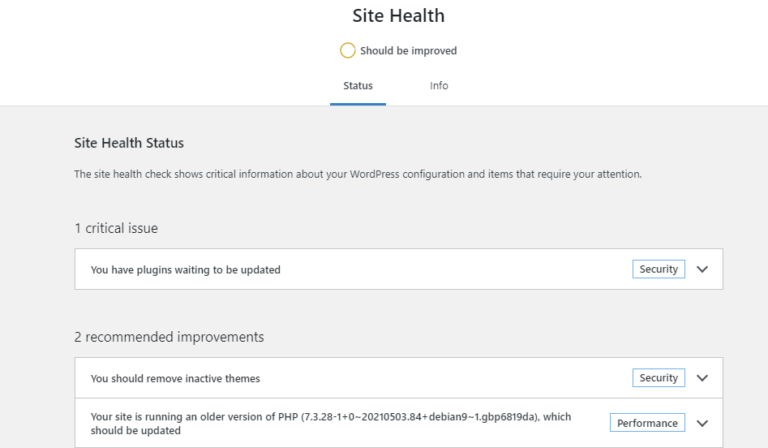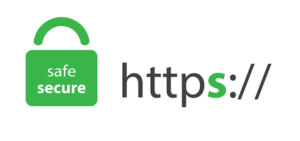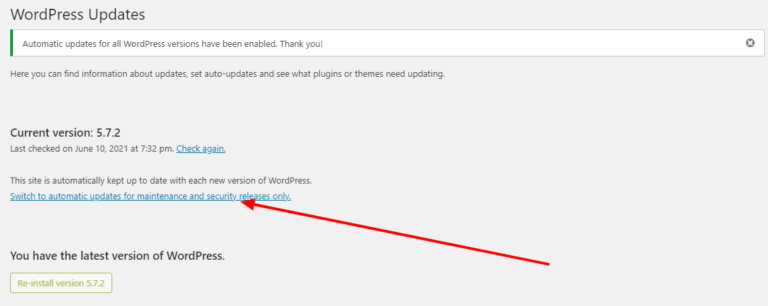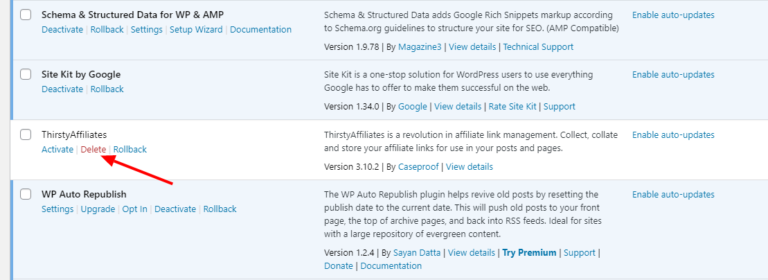The first time your website went online, everything (hopefully) looked good – the speed, user-friendliness, performance, and security. However, you may have noticed that your site’s performance is dropping over time, and your visitors don’t seem to be returning. What could be causing this?
When you start noticing a drop in your website’s performance, one of the foremost things to do is to run a health check or a complete website analysis. Unfortunately, though, many website owners fail to pay enough attention to their site’s health. However, this is integral.
Luckily, the WordPress 5.2 update introduced a number of new features and improvements, which included a “Health Check” function. This health check feature analyzes your WP site and gives you an overall rating, which tells you how “healthy” your site is. Factors checked by this feature include your website’s performance, speed, and security.
What’s the WordPress Health Check?

For your website to pass the built-in health check on WordPress CMS, you only need to update your plugins, themes, and PHP framework. Once everything that powers your website is up to date, you’ll be able to score a perfect 100% in the check.
However, keeping everything up to date doesn’t guarantee that your site is “Healthy.” And as such, today’s guide will explain several key professional tips to help keep your WordPress site’s health at a high overall.
Professional Tips to Maintain a Healthy WordPress Website
Keep everything up to date
Developers usually release new versions of their products on a relatively regular timeline. These new versions try to fix any errors, points for improvement, bugs, and security glitches in their predecessors.
Without a doubt, almost every WordPress site runs with at least a handful of plugins, themes, and frameworks, and all of these need to be regularly updated to their latest versions to keep your site healthy.
Moreover, the WordPress core itself is updated by the company from time to time; when it rolls out, a notification is delivered to all WP sites. You should always run the update at the first possible opportunity to keep things healthy once it appears on your admin dashboard.
The purpose of keeping everything up to date is to mitigate the chances of cyber-attacks. Moreover, this simple step helps keep your website functioning perfectly.
How To Update Your Site’s Resources
Use HTTPS
Surprisingly, not all sites use HTTPS protocols to date. Of course, if your site still runs on HTTP, you’ll need to install a security certificate to make it run on HTTPS protocol.
Personally, you may not be all that concerned about HTTP and HTTPS. However, for SEO purposes and assuring your visitors that your site is safe to browse, HTTPS is almost compulsory.
Interestingly, there are a couple of ways to get HTTPS for free for your website. For example, most managed WordPress hosting packages come with free SSL, making your site run on the HTTPS protocol with no additional fees. In addition, Cloudflare also offers free SSL certificates to power WordPress sites to run HTTPS protocol.
How To Detect a Site That Runs HTTPS
When you visit a website that runs on HTTPS, you’ll see a padlock appear just before the site’s domain URL on the address bar. This is something most tech-savvy users now look for when searching for a website.
Set up Automatic Updates
You can configure automatic updates directly from your WP admin dashboard or the cPanel. Luckily, configuring automatic updates helps you focus on other, more important things while your website’s core resources and plugins automatically update to the latest versions.
The built-in, automatic updates feature on WordPress only updates your plugins and themes; it doesn’t automatically update your site’s framework (PHP) or databases (MySQL). As such, to update these critical aspects of your website’s structure, you may have to go through the control panel instead, which is a more advanced action.
How To Set Up Automatic Updates
Enable WordPress Rest API
Disabling Rest API may impact the performance of some of the plugins and themes that power your WP site. Therefore, it’s typically advisable to leave REST API enabled since it provides an interface for 3rd-party applications and plugins to interact with the core WordPress API.
Disclaimer: Most website owners purposefully disable REST API to protect their sites from brute force attacks. As such, you only need to enable this API if you’re more concerned about having your website score high in the WP Health Check analysis – but it’s integral to ensure your site’s security is maintained and monitored at all times.
Enable WP-Cron Jobs
How To Manage WordPress Crons
Use the Best PHP Version and Modules
Delete any inactive plugins and themes
There will often be inactive themes and plugins running on your site. You simply need to delete them if you’re certain you don’t need them anymore. However, there is no limit as to the number of plugins you can run on your WP site. Moreover, whether or not you delete inactive plugins, your website’s performance likely won’t be affected unless the plugin was using a substantial amount of storage space.
The main reason to delete inactive tools is simply to mitigate the chances of malware attacks on your site. You will need to first deactivate a plugin before you can delete it entirely from the site.
Always update your site’s database
WordPress sites run on the MySQL database. When a database is buggy and underperforming, it affects the website’s overall performance. As such, just as with selecting the best PHP settings for your website, updating or upgrading your site’s database must be done from the cPanel or app back-end.
You should always ensure your site is running the newest stable version of MySQL to promote your website’s overall health score. This is since the database is where all information regarding your website is saved; as such, this factor should naturally be handled with the utmost care.
Summary
Making your WordPress site healthier shouldn’t have to be an impossible goal – and we hope that today’s tips will help improve your WordPress site’s health score overall. And while you shouldn’t solely focus on your site’s health score rating, a 100% score implies that your site has great potential to stay at the forefront in terms of the competition.
However, before applying any of the information mentioned in this article, always ensure you first create a comprehensive backup of your website – just in case things don’t turn out well. And remember: this article is mainly for information purposes only. As such, any changes should only be made with guidance or advice from your specialist web developer.











